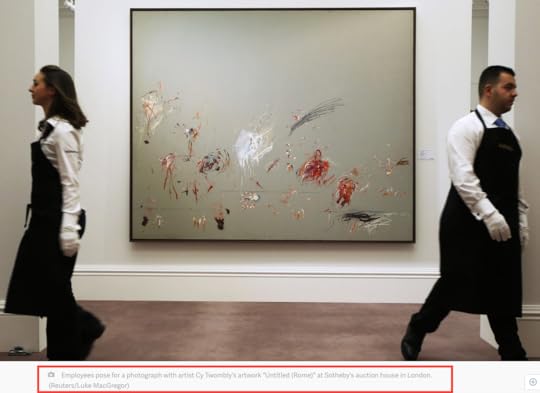Grant McCracken's Blog, page 9
December 3, 2015
The Grinder and the perils of celebrity culture
 The Grinder is a show from FOX about a TV actor (Rob Lowe as “Dean”) who leaves his hit series, a courtroom drama, to spend some time in the “slow lane.” He wants to make contact with “real life,” to break away from the insincerities of Hollywood and the falsehoods of a celebrity culture.
The Grinder is a show from FOX about a TV actor (Rob Lowe as “Dean”) who leaves his hit series, a courtroom drama, to spend some time in the “slow lane.” He wants to make contact with “real life,” to break away from the insincerities of Hollywood and the falsehoods of a celebrity culture.
His plan is to help himself to the small town existence of his brother (Fred Savage as “Stewart”). The star just moves in…to Stewart’s home, his strip-mall law firm, and his life.
In effect, Dean hijacks his brother’s life. Because celebrities are our gods and they can do anything they want…within reason. Forget reason. Really, the world belongs to them.
One of the pleasures of The Grinder is that it holds celebrity culture up for scrutiny. We see ourselves, witless with admiration. And we see what happens to the celebrities when treated to this constant flow of astonished gratitude. They turn into very handsome monsters.
The best moments in The Grinder come when the Rob Lowe character demonstrates that he really can’t tell the difference between his celebrity and the rest of his world. Much of the time he believes that he is a lawyer and that the world is his TV courtroom.
This leads to pronouncements that sound ok on TV but when uttered in the real world of a small strip-mall law firm in the middle of nowhere are just gloriously, magnificently delusional.

And this calls for wonderful moments when the listeners are called upon to witness the delusion. Clearly, they are torn. Part of them wants to go along. After all, celebrities make our collective reality, why not defer to them when they presume to make our personal reality?
But reason prevails. And the listener, often Fred Savage, responds with that wonderful facial expression that says, “does he really not know how delusional that sounds?” Fred Savage is a master of this expression. So is Mary Elizabeth Ellis, his wife on the show.
I couldn’t find a perfect image to capture it. The one at the top of the post comes closest. I think this is the way you make it: turn your head a little to the side, let the smile of approval freeze into the beginning of a grimace, widen the eyes with a look of concern edging on alarm.
It’s worth getting this right. With Washington shaping up the way it is, we’re going to need it.
November 25, 2015
My Tribe Is an Unsophisticated People
 This is a photograph of Sara Little Turnbull (1917–2015). Sara was an designer and anthropologist. In 1988 she founded, and for 18 years she ran, the Process of Change Laboratory for Innovation and Design at the Stanford Graduate School of Business.
This is a photograph of Sara Little Turnbull (1917–2015). Sara was an designer and anthropologist. In 1988 she founded, and for 18 years she ran, the Process of Change Laboratory for Innovation and Design at the Stanford Graduate School of Business.
I like this photo for a couple of reasons. Sara was caught at her desk, mid-task, mid-thought. She senses the camera and gives it a knowing look. What’s maybe most striking is her clothing. Ever so fashionable. Ever so anti-anthropological.
My tribe dresses badly. Jeans. It takes a lot of denim to clothe the field. We don’t ever dress up. The idea appears to be to dress as far down as possible without provoking the suspicion of vagrancy. When formal clothing is called for the anthropologist sometimes resorts to the clothing of the culture they study. Put it this way, no one ever looks like Sara.
A lot of this is “badge of pride” stuff. Anthropologists dress badly to make a point. They want you to know that they reject the conventions of a mainstream society, that they care nothing for the bourgeois respectability, upward mobility, and/or conspicuous consumption that animate the dress codes of the rest of the world. It’s not a punk violation of code. It’s just a way of saying “Look, we’re out.”
This strategy is not without it’s costs. As Marshall Sahlins, God’s gift to anthropology, used to say in his University of Chicago seminars, “every theory is a bargain with reality.” (By which we believed he meant, every theory buys some knowledge at the cost of other knowledge.) And so it is with every suit of clothing. It give you access to some parts of the world, but it denies you access to others.
This social immobility is not a bad thing if you are a nuclear scientist or a botanist. But it does matter if you are prepared to make claims to knowledge when it comes to your own culture, and anthropologists are never shy on this topic.
Anthropologists believe they know about a great deal about their own culture. But in point of fact, there are many worlds they do not know and cannot access, worlds of which they have scant personal knowledge and in which they have few personal contacts. Generally speaking, they don’t know anyone in the worlds of venture capital, advertising, graphic design, publishing, fashion, forecasting, strategy, philanthropy, art museums, professional sports, industrial design, user experience, startup capitalism, banking, branding, public relations, small business, big business, or politics. It’s a lot, the things anthropologist don’t know about their own culture.
Anjali Ramachandran recently heard Salman Rushdie speak in London and recalls he said something like,
“One thing I tell students is to try and get into as many different kinds of rooms to hear as many different kinds of conversations as possible. Because otherwise how will you find things to put in your books?”
Just so. Rushdie’s “many rooms” strategy is not embraced in anthropology. By and large, anthropologists encourage their students to stick to a small number of rooms where, by and large, they conduct the same conversation.
This is ironic not least because one of the field’s most recent and convincing contributions to the world beyond it’s own is actually a contemplation of the danger of living in a silo. Gillian Tett (PhD in social anthropology, University of Cambridge) recently published a book called The Silo Effect: The Peril of Expertise and the Promise of Breaking Down Barriers. This is a book about the compartmentalization of all organizations, but it might have been a study of the field of anthropology.
The further irony is that in its post-modern moment, anthropology claims to be especially, even exquisitely, self reflexive, but the sad thing is that it does ever seem to be reflexive on matters like this. Clifford Geertz used to say that much of anthropology is self confession. Too bad that’s no longer true.
Irony gives way to something less amusing when we see that this provincialism is not just self-imposed but enforced as a tribal obligation. Those who dare dress “up” or “well” or “fashionably” or, as we might say, “in a manner that maximizes cultural mobility” is scorned. As graduate students, we actually dared sneer at the elegant suits sported by Michael Silverstein. How dare he refuse this opportunity to tell the world how world-renouncing he was! There is something odd and a little grotesque about willing a provincialism of this kind and then continuing to insist on your right to make claims to knowledge.
Sara Little Turnbull knew better. She understood how many mansions are contained in the house of contemporary culture. She embraced the idea that anthropology was a process of participant observation and that we can’t understand our culture from the outside alone. Sara also understood that the few “ideas” that anthropology uses to account for this endlessly various data is a little like the people of Lilliput hoping to keep Gulliver in place on the beach with a couple of guy wires. Eventually the beast comes to. Sara could study contemporary culture because she didn’t underestimate it or constrain her rights of access.
This post is dedicated to Sara Little Turnbull who passed away September 4, 2015.
This post first appeared on Medium.
Photocredit: Center for Design Research
October 8, 2015
Who is the next Frank Sinatra?
I spent the last couple of days in Palm Springs. (I was giving a talk to NBC.)
I gave myself a day to wander around.
Palm Springs does not have superb powers of historical evocation. (For some reason I thought it would.) But you can catch a glimpse of a world built for and by several generations of celebrity, including Frank Sinatra.
At a distance of several decades and several generations, Frank is looking odder and odder. The total self confidence. The overweening self importance. All that “chairman of the board” stuff. The booze. The “dames.” The “rat pack.”
But if you talk to someone of Frank’s generation, it’s clear the guy was a god, a personification of the qualities people found spell binding.
Who, I wondered, is Frank Sinatra now? Who is the person who exhibits this perfect connection with the cultural moment. There are lots of options. Jon Stewart has a shot at the “crown.” Jay-Z does too. [Suggestions, please.] And, sure, it’s tougher to say now that we are so fragmented.
There’s a chance it’s Bill Murray. Not least because he helped unseat the lounge singer with his SNL work. But also because he has reinvented himself several times over a series of movies. Young film makers found him and found him useful.
The real reason he is the new Frank is that he is the anti-Frank. He appears to have no interest in creating that huge personality that dominates the public stage. To be sure, there is a distinct personality, one that sits on the surface of all the film work. And this personality is all about a perfect self mastery, that’s quite Frankish, even as it is an exercise in irony that scorns everything Frankish.
What do you say? Who is the new Frank Sinatra?
October 5, 2015
Remove Killers from Memory and the Human Community
Last week Douglas County Sheriff John Hanlin asked us not to name the man responsible for the killings at the community college in Oregon.
And the debate begins.
Josh Marshall takes issue with Hanlin. He says that withholding the shooter’s name is a kind of evasion. : “Withholding knowledge is not the way forward.”
I disagree. I think we should always withhold the names of killers. I think their punishment must include obscurity. We might want to go so far as an “unmarked grave.” I say excise their names from our collective memory, oral tradition, and media coverage, short cycle and long.
Here’s why.
I expect these killers mostly conform to the stereotype we have of them. They are basement-dwelling losers, ignored when not scorned when not despised. (This notion may be a confabulation created by news programmers and CSI writers. Only research will tell.)
But if the stereotype is right, we can imagine the nonsense circulating in monsters’ heads. “My name will be legend. People will talk of me. My name will provoke fear and trembling.” This sounds like the stuff of video game narrative and fantasy fiction, and that might be where it comes from. (No cheap shot intended here.)
And if this is the motive that drives, then our strategy is obvious. We must deny monsters their wish. We must eradicate the motive that drives them. We must remove them from the human community.
September 8, 2015
Donald Trump is a fireship
The question in yesterday’s post was:
Why has Donald Trump survived our discovery of his flaws and deficiencies?
Normally, a new candidate has his or her moment in the sun, until we discover who they really are. Then they’re done.
But this doesn’t ever happen in Trump’s case, however damning the revelations.
The answer, I think, is that his supporters don’t want a president. They want a fireship.
Fireships were instruments of destruction when the world was ruled by wooden ships. The idea was to pack a ship with flammables, set it ablaze, and send it in the direction of enemy ships in the hope that it would set these enemy ships ablaze. Fireships helped defeat the Spanish armada gathered in the English Channel.
Donald Trump promises to make a very good fireship. He lacks the subtlety, intelligence, breadth, and leadership we look for in a candidate. And that’s precisely what makes him such an effective instrument of political disruption.
Reckless, boorish, self centered? Perfect. Trump’s flaws make him a unassimilable. Washington is its own empire with formidable powers of hegemony. Many reformers go to Washington. Virtually all are claimed, colonized, incorporated. The Trumpians believes they have found a candidate so full of himself not even the Borg can absorb him. (If you can’t have incorruptible, unassimilable will have to do.)
But that’s just Step 1 of the Trump disruption, the passive play. Step 2, the active play, is a candidate who thinks he’s smarter than the system. Most Trumpians know that Trump isn’t smarter than the system. They just want him to act as if he is. That guarantees the destructive chaos they’re hoping for. I don’t think anyone doubts that Trump is a bully and a blow hard. They just want him to knock lots of things down when he throws his weight around. (If you can’t have cunning, clumsy will have to do.)
Trumpians don’t want a candidate. They want an agent of chaos. They don’t want to reform Washington. They want to burn it down.
September 7, 2015
Donald Trump defies the Dorian Gray effect. Why?

I found this wonderful image at the train station in my hometown in Connecticut.
Scratched into an ad on the platform, someone left us a “Dorian Gray” treatment of Donald Trump.
Behold the man behind the mask.
But that’s the thing about Trump. No one seems to care about his deficiencies or his flaws.
This departs from the normal practice of American politics. Normally, it goes like this.
An outsider appears in American politics. He or she expresses some deeply felt issue. There’s a brief period of enthusiasm.
Then the reporters go to work. Debates happen. Interviews are given.
And eventually we get a Dorian Gray revelation of the real man or woman.
And hey presto, that’s the end of their candidacy. (And, like a booster rocket, the candidate falls away even as the issue continues. The candidate has served his or her purpose.)
But it’s not happening this time.
Why isn’t happening this time?
September 4, 2015
September 2, 2015
Less public knowledge, more private meaning (lessons for politicians and brands)

This is a part of a map of London drawn by Fuller (aka Gareth Wood).
Wood says that he created a map to show his relationship with the city over several years.
“It’s about documenting a particular time and experience.”
Wood’s map of London ends up being a personal document.
Of course personal is the last thing that maps are supposed to be. They are supposed to come from official sources and authoritative parties. In an almost magical act of abstraction, they remove everything that has anything to do with anyone. There are millions of people in London interacting with the city in many millions of moments. Mapmaking is meant to make all that disappear. We give you London, all place, no time, all place, no people, all place, no particulars. At all.
Something in us now recoils from this abstraction. Authoritative meanings are on the run. But of course we will continue to need maps of the old fashion, abstract kind. Chances are we will never use Wood’s map actually to find our way around London. (Though that’s a pretty charming idea and it’s easy to imagine a guest who is very late for a dinner party giving as her plaintive explanation that her Fuller map is “really not all that helpful when you get right down to it.”)
But more and more we like a world that vibrates with particularities. Public knowledge seems a little thin. Authoritative versions of the world seem a little unforthcoming if not positively stingy. Surely, we think, the world, and especially London, is more interesting than this.
This shift in expectation runs through us with big consequences. Political figures must learn from it. Romney seemed very “official map.” Obama seemed somehow more particular. (Though he never did get all that personal.) Hillary is very official map. It’s as if so much of what makes her personal plays to her disadvantage that she wants to get abstract and stay that way. Every politician needs to solve this problem. How to show the real person, the authentic individual, even when everything in them screams to keep the image airbrushed. In his strange, deeply stupid manner, Trump has addressed this problem.
Things are easier in the world of the brand. Every brand has been struggling to make itself less official and more particular for some time. This means letting in the consumer and the world in ways that were once unforgivable. American brands used to be very abstract indeed. But they are (marginally) less alarmed about making the transition away from abstraction. Out of the USP into life. I always thought Subaru has done a nice job of this.
It’s a good exercise for a politician or a brand. If your present self is a formal map of who you are, what would Gareth Wood’s version look like? Creatives, planners, brand managers, campaign managers, please let me know if you try this and it works.
Acknowledgment:
For more on Wood and his map, see the excellent coverage by Greg Miller here.
September 1, 2015
Cultural Leaders and Laggards, the problem with beer ads
I love this ad. How quickly bashful behavior gives way to full-on performance. And how this disappears (when the woman enters the store). And then reappears (when it occurs to our singer that there is a small chance the strangers might actually come listen to him.)
Funny. Human. With lots of little grace notes. The store is brilliantly cast. The singer is that perfect combo of surprisingly good and still terrible. The way the woman rolls her eyes in “whatever” dismissal when she enters the store to find a man singing.
Beer advertising has been the bad part of town when it comes to cultural creation and creative ingenuity. TV with the advent of really good shows and new nuance has stolen the lead. Now it can be really painful to move from good narrative to bad advertising.
Beer advertising has been especially trying on the gender theme. As Bob Garfield has pointed out, beer ads treat men in a way that’s patronizing and diminishing. In a really symmetrical universe, men would protest this treatment with outrage and boycotts. (Or at least roll their eyes in “whatever” dismissal.)
Beer advertising has been tone deaf when it comes to culture. Yes, some guys continue to act like dolts, and all guys treasure moments of deep, unapologetic stupidity at least some of the time. But beer advertising has to wake up and come to grips with the revolutions taking place in the world of maleness.
There are all kinds of things, a new feeling for play, wit, creativity, multiplicity and, yes, performance. Which brings us back to this Miller Lite ad which acknowledges this new development with just the right combo of tender heartedness and ruthless scorn. Very male that. (Or maybe not.)
Hat’s off to MillerCoors Chief Marketing Officer Andy England and TBWA\Chiat\Day LA and director Matt Aselton of Arts & Sciences.
April 21, 2015
Narrative captivity: Losing Orphan Black for want of a half-fan
 I am a long standing fan of Orphan Black but this season they lost me. I tuned in for the opening episode of the new season, and it wasn’t long before my eyes had crossed.
I am a long standing fan of Orphan Black but this season they lost me. I tuned in for the opening episode of the new season, and it wasn’t long before my eyes had crossed.
In the new season, it feels as if Orphan Black is being made to labor under the weight of its own complexities. And with all the clones in motion, these complexities are formidable. And with two seasons in place, there are many additional plot points and precedents to honor.
Tedium, thy name is consistency.
Showrunners Graeme Manson, Ivan Schneeberg and David Fortier must of course honor the story. Fans, especially, are ferocious in their defense of its integrity. But the rest of us really are not engaged in narrative book-keeping in any kind. We love the actress, her clones, and the broad story lines that give her an opportunity to dazzle us with her virtuosity, lend some urgency to the story at hand, identify the goodies and the baddies, and that’s enough for us.
We want some sense of narrative development. We want our heroine to mature or at least change (or at least clone) as pluckily she survives. But give us the big picture, not what feel like pages of gawky exposition in which good actors are brought low by the need to belabor plot points. These moments almost feel like writers and directors clarifying story complexities for their own sake, and when this happens we know that undue complexity has hijacked the show. Narrative captivity, it’s a terrible thing.
We see why this happens. After a couple of seasons, the people who make the show have mastered the finest plot points better than the best Yeshiva student. And fans! Fans live and breathe the show and they often appoint themselves the guardians of the story line. (“You want me on the wall. You need me on that wall.”) And in a sense this is like any corporate culture, where the incumbents fall into a gravitational field and eventually can’t believe that everyone doesn’t live there too.
There are a couple of ways of fixing this. One is to have an ethnographic panel of half-fans. These are people who love the show but live in distant orbit around it. They know the characters and the major plot points, but they don’t know or care about the very fine details. Writers, directors and show runners can call them up from time to time and say, “So tell me about the show” and they can use this as a chance to recalibrate. It’s a question of optics. We can hold up the half-fan’s view of the story and change the way we see the show. Or think of it as a time machine. We can use the half fans knowledge of the show to recover the way we understood it in the first season.
Naturally, half fans, some of them anyhow, will evolve into full fans. And it will be up to the person running the panel to replace them with more half fans. In fact we should think of the panel as a bend in the river, a place where half fans slow for long enough for us to quiz them…before they run downstream to full fan status.
I don’t know who want to take this on. And it would be presumptuous to suggest a name. So I will. Dee Dee Gordon could do this brilliantly. What we need, Dee Dee, is a panel of half fans. As someone starts a new show, they will ask you to empanel this panel, and from time to time they will use it to see their shows (as many, most) others do. In effect, the half fan panel (now, HFP, because that sounds way more official) is a rope that the showrunner wears around his/her waist while descending into the narrative mine shaft. A couple of sharp tugs and they can return to the surface.





